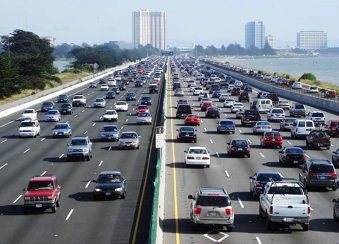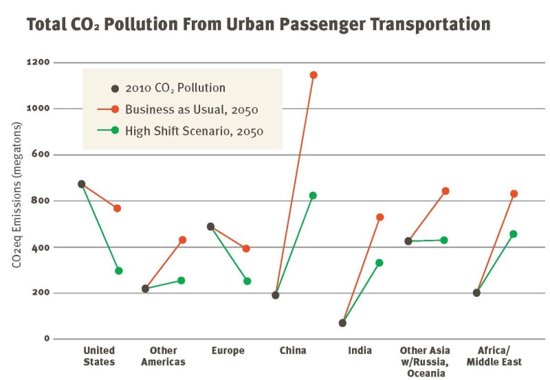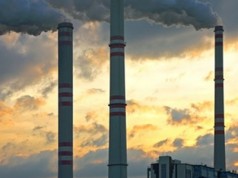
New York – More than $100 trillion in cumulative public and private spending, and 1,700 megatons of annual carbon dioxide (CO2) – a 40 percent reduction of urban passenger transport emissions – could be eliminated by 2050, if the world expands public transportation, walking and cycling in cities, according to a new report released by the University of California, Davis, and the Institute for Transportation and Development Policy (ITDP).
Further, an estimated 1.4 million early deaths could be avoided annually by 2050 if governments require the strongest vehicle pollution controls and ultralow-sulfur fuels, according to a related analysis of these urban vehicle activity pathways by the International Council on Clean Transportation (ICCT) included in the report.
“Transportation, driven by rapid growth in car use, has been the fastest growing source of CO2 in the world,” said Michael Replogle, ITDP’s Managing Director for Policy and co-author of the report. “An affordable but largely overlooked way to cut that pollution is to give people clean options to use public transportation, walking and cycling, expanding mobility options especially for the poor, and curbing air pollution from traffic.”
“The analysis shows that getting away from car-centric development will cut urban CO2 dramatically and also reduce costs, especially in rapidly expanding economies,” said report co-author Lew Fulton, Co-director of NextSTEPS Program at the Institute of Transportation Studies at UC Davis. “It is also critical to reduce the energy use and carbon emissions of all vehicles.”
The report, “A Global High Shift Scenario: Impacts and Potential for More Public Transport, Walking, and Cycling with Lower Car Use”, is the first study to examine how major changes in transport investments worldwide would affect urban passenger transport emissions as well as the mobility of different income groups. The authors calculated CO2 emissions in 2050 under two scenarios, a business-as-usual scenario and a “High Shift” scenario where governments significantly increased rail and clean bus transport, especially Bus Rapid Transit (BRT), and helped urban areas provide infrastructure to ensure safe walking, bicycling and other active forms of transportation. The projections also include moving investments away from road construction, parking garages and other ways that encourage car ownership.
Under this High Shift, not only would CO2 emissions plummet, but the net financial impact of this shift would be an enormous savings over the next 35 years, covering construction, operating, vehicle and fuel-related costs.
The report was released at the United Nations Habitat III Preparatory Meeting in New York on September 17, in advance of the September 23rd United Nations Secretary-General’s Climate Summit, where many nations and corporations will announce voluntary commitments to reduce greenhouse gas emissions, including new efforts focused on sustainable transportation.
“This timely study is a significant contribution to the evidence base showing that public transport should play central role in visions for the city of tomorrow,” says Alain Flausch, Secretary General of the International Association of Public Transport, and member of UN Secretary General’s Advisory Group on Sustainable Transport.

Better Mobility Leads to Social Mobility
The new report also describes sustainable transportation as a key factor in economic development. Under the High Shift scenario, mass transit access is projected to more than triple for the lowest income groups and more than double for the second lowest groups. Notably, the overall mobility evens out between income groups, providing those more impoverished with better access to employment and services that can improve their family livelihoods.
“Today and out to 2050, lower income groups will have limited access to cars in most countries under almost any scenario; improving access to modern, clean, high-capacity public transport is crucial,” said Fulton.














